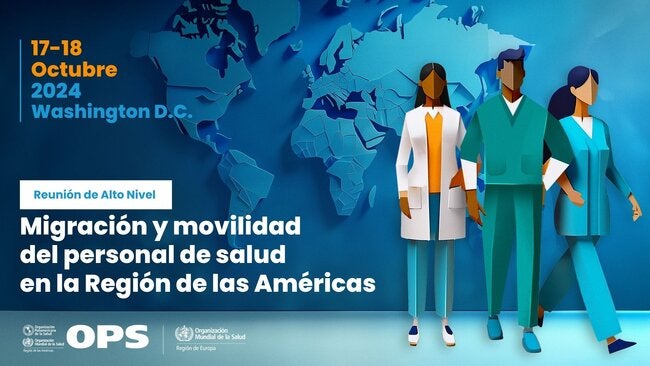High Level Meeting on Migration and Mobility of Health Personnel in the Region of the Americas – PAHO/WHO
High Level Meeting on Migration and Mobility of Health Personnel in the Region of the Americas
Date: October 17 and 18, 2024
Place: Conference Room B, PAHO/WHO Headquarters, Washington, DC
Format: In-person.
Goals
- Engage in a high-level dialogue on issues related to migration and mobility of health workers and define strategic directions for a roadmap in line with the WHO Global Code of Practice on International Recruitment of Health Workers.
- Reach agreement on key policy areas to optimize the benefits of migration and mitigate its negative effects in the Region.
- Identify innovative mechanisms to foster collaboration between countries in order to achieve equity and promote the exchange of knowledge around the migration of health personnel, facilitating the obtaining of specific solutions for the Region of the Americas.
Background
International mobility and migration of health personnel has steadily intensified over the years. Between 2008 and 2018, migrant medical and nursing staff in Organization for Economic Co-operation and Development (OECD) countries increased by 60% (1). In eight high-density OECD countries, the percentage of medical staff trained abroad increased from 32% in 2010 to 36% in 2020 (2). This trend was exacerbated by the COVID-19 pandemic. Economic projections regarding the demand and supply of health professionals appear to indicate a continued increase in the displacement of health personnel around the world. Furthermore, the persistent global shortage of human resources for health is widespread, but not evenly distributed across regions. By 2030, Latin America and the Caribbean (LAC) is expected to be among the regions with the greatest net shortages (3).
The migration of human resources for health (HRH) from low- and middle-income countries is a global health problem with important implications for both countries of origin and destination, shaped by a complex interrelation of factors. of expulsion and attraction at the individual and systemic level. At the individual level and in relation to migration, better employment opportunities, working conditions and career prospects, as well as higher salaries, are pull factors. At a systemic level, weak health systems, limited career development opportunities, political instability and poor governance can be push factors for HRHs, driving them to seek employment elsewhere. In addition, the global distribution of health personnel is influenced by macroeconomic factors such as the globalization of the economy, international trade agreements, rigidity of supply systems and aging populations in high-income countries, which increases the demand and intensify labor force migration from low- and middle-income countries (4).
In the Region of the Americas, the phenomenon of migration and mobility of health personnel is not recent, but has become a pressing issue in recent years due to the great shortage of health personnel in low-income countries. and medium. In the case of Central America and the Caribbean, the capacity of health systems to respond to public health emergencies and provide essential health services to meet the health needs of the population has been compromised. The migratory flow has been exacerbated by private, for-profit companies dedicated to recruiting personnel, which are entering this market in increasing numbers and influencing migration patterns.
A study carried out in 2023 by PAHO and the Caribbean Commission on Human Resources for Health (5) showed that, with regard to migration, the main expulsion factors are inadequate remuneration, few opportunities for professional development and stressful work conditions. The prospect of better salaries appears to be a strong motivator for migration in the Caribbean subregion. A study published in 2019 (6) on remuneration disparities between health personnel working in the Caribbean and those working in selected destination countries showed that the purchasing power parity (PPP) of adjusted salaries of HRH in three selected destination countries (Canada, United States and United Kingdom) is much higher than that of comparable HRHs working in selected Caribbean countries (Dominica, Grenada, Jamaica and Saint Lucia). This could explain why for HRHs who were trained and work in the Caribbean subregion, financial incentives continue to be a strong motivation for migration.
The proposed Human Resources Roadmap for Health in Central America and the Dominican Republic, prepared under the direction of the Council of Ministers of Health of Central America and the Dominican Republic (COMISCA) in 2023, highlights the urgent need to address the high rates of migration and mobility of health personnel (7). The priorities are to guarantee decent working conditions and protect health personnel. Measures such as improving the labor market, security conditions and promoting bilateral agreements are also crucial to address this issue.
In some countries, insecurity and political instability play a fundamental role in migration, including that of health personnel, who tend to seek better opportunities within and outside the Region.
According to OECD data from 2017 to 2021, the countries with the largest number of doctors trained in Latin America are Germany, Canada and Chile. Most of these doctors come from Colombia, Ecuador and Venezuela. Large numbers of foreign-trained nurses from the English Caribbean emigrate to Canada and the United Kingdom; the majority of nurses come from Barbados, Guyana, Jamaica and Trinidad and Tobago (8). There is also an important socioeconomic factor that must be considered as an expulsion factor, especially in the case of nursing staff, mostly women, who earn 20% less than men, have little access to leadership positions and are underrepresented in positions. at a high level, both in health systems and in the political sphere (9).
By 2030, there will be a shortage of between 600,000 and 2 million health professionals in Latin America and the Caribbean (10-12), a shortage that will be distributed unevenly within and between countries. The migration of health professionals represents a form of brain drain from the most affected subregions and countries, which will record the majority of the HRH shortfall projected by 2030. Furthermore, the shortage is already greatest in rural and underserved areas , leading to pronounced disparities in health care (4).
Migration and mobility of health personnel are issues of great relevance for the labor market. Considering that the health sector is one of the main employers in many countries, the immigration issue influences spheres that are under the supervision not only of the ministry of health, but also of the ministries of labor and education. On the other hand, much less attention has been paid to the mobility of health personnel, an area in which more in-depth analysis is needed.






